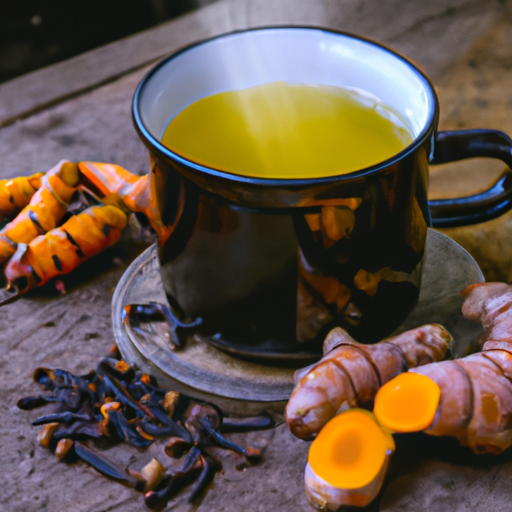Turmeric is often compared to a superhero in the realm of spices, known for its powerful anti-inflammatory abilities. Just like a superhero battles against enemies, turmeric can effectively combat inflammation, a key factor in numerous long-term health conditions. One common method of turmeric consumption is through turmeric tea, but does it truly deliver on its reputation as an inflammation-fighting powerhouse?
Let’s explore the science behind turmeric’s active ingredient and the potential health benefits of drinking turmeric tea. If you’ve ever experienced redness, swelling, or pain in response to an injury or illness, you’ve experienced inflammation. While inflammation is a necessary part of the body’s immune response, chronic inflammation can lead to a host of health problems, such as heart disease, cancer, diabetes, and arthritis.
That’s where turmeric comes in. Its active ingredient, curcumin, has been shown to have anti-inflammatory properties that can help reduce chronic inflammation and its associated health risks. But before you reach for that turmeric tea bag, it’s important to understand the science behind how it works and any potential side effects.
Key Takeaways
- Turmeric tea contains curcumin, a compound with potent anti-inflammatory properties that can help lower inflammation in the body, which is associated with chronic diseases like heart disease, diabetes, and cancer.
- Consuming curcumin with black pepper or fats can enhance absorption and increase bioavailability, making turmeric tea an effective way to improve the absorption of curcumin.
- Turmeric tea has anti-viral, anti-bacterial, and anti-fungal properties that can help protect the body from illness and infection.
- Managing dosage is important when incorporating turmeric tea into the diet, as turmeric in large doses can cause stomach upset and even ulcers, and individuals with specific health conditions should exercise caution when including it in their diet. It’s also important to use high-quality turmeric powder and to avoid boiling the tea to preserve the beneficial compounds in the spice.
What is Turmeric and How is it Used?
Turmeric’s popularity has been on the rise due to its versatility in cooking and its potential health benefits. As a spice, turmeric is commonly used in Indian and Middle Eastern cuisine to add flavor and color to dishes.
Turmeric cultivation dates back to ancient India, where it was considered a sacred spice and used in religious ceremonies. Today, turmeric is grown in many parts of the world, including India, China, and Indonesia.
Aside from its cultural significance, turmeric has gained attention for its potential health benefits. Curcumin, the active ingredient in turmeric, has been found to have anti-inflammatory and antioxidant properties.
This has led to research on the potential use of turmeric in reducing inflammation and preventing chronic diseases. With this in mind, let’s take a closer look at the science of inflammation.
The Science of Inflammation
Now let’s dive into the science of inflammation. You’ll learn about the differences between acute and chronic inflammation and how they affect the body.
Plus, we’ll explore the link between inflammation and disease, so you can better understand how inflammation impacts your overall health.
Get ready to discover the fascinating world of inflammation and its role in your body.
Acute vs. Chronic Inflammation
Acute inflammation is a natural response to injury or infection, but chronic inflammation can lead to serious health conditions such as heart disease and cancer – a shocking 60% of all deaths worldwide are linked to chronic inflammation. To better understand the difference between acute and chronic inflammation, consider the following:
-
Acute inflammation is typically short-lived and localized to a specific area of the body, such as a cut or scrape.
-
Chronic inflammation, on the other hand, persists over a longer period of time and can affect multiple areas of the body.
-
Acute inflammation is a necessary step in the healing process, as it helps to remove damaged tissue and promote the growth of new tissue.
-
Chronic inflammation, however, can lead to tissue damage and scarring, and it’s often associated with a wide range of health issues, including arthritis, diabetes, and Alzheimer’s disease.
Understanding the difference between acute and chronic inflammation is important for managing each, particularly when it comes to natural remedies. While acute inflammation may not require treatment beyond basic first aid, chronic inflammation often requires a more proactive approach.
In the next section, we’ll explore alternative treatments for chronic inflammation and the link between inflammation and disease.
The Link Between Inflammation and Disease
Chronic inflammation can be compared to a wildfire, spreading throughout the body and causing damage that can lead to serious health conditions such as heart disease and cancer. This is because inflammation is a key player in the development of many chronic diseases.
For instance, studies have shown that chronic inflammation can lead to insulin resistance and type 2 diabetes, as well as neurodegenerative diseases like Alzheimer’s. Fortunately, there are several ways to reduce chronic inflammation, including dietary interventions and lifestyle modifications.
Dietary interventions are one of the most effective ways to reduce chronic inflammation. For example, foods that are high in antioxidants, omega-3 fatty acids, and fiber have been shown to reduce inflammation. In addition, consuming a diet rich in fruits and vegetables has been linked to lower levels of inflammatory markers.
Lifestyle modifications such as regular exercise, getting enough sleep, and reducing stress levels can also help reduce inflammation. These modifications have been shown to decrease the levels of inflammatory markers in the blood. With this in mind, it’s worth exploring the active ingredient in turmeric, which has been shown to have anti-inflammatory properties.
The Active Ingredient in Turmeric
So, you want to learn more about the active ingredient in turmeric? Well, let’s start with curcumin – the component responsible for the spice’s vibrant yellow color and potential health benefits.
Curcumin is known for its anti-inflammatory and antioxidant properties, making it a popular supplement for those seeking to improve their overall health. However, one of the challenges with curcumin is its low bioavailability, or the amount that can be absorbed and utilized by the body.
Curcumin and its Properties
Curcumin, a compound found in turmeric, is known for its anti-inflammatory properties. Studies have shown that it can help reduce inflammation in the body by blocking certain molecules that play a role in the process. However, it is important to note that the benefits of curcumin may not be fully realized by simply consuming turmeric in its natural form.
This is where curcumin supplements come in. These supplements contain higher concentrations of curcumin than turmeric alone, making it easier to achieve the desired dosage. It is recommended to take curcumin supplements with meals to enhance its absorption and bioavailability. In the table below, you can see the recommended curcumin dosage for various health conditions.
| Health Condition | Recommended Curcumin Dosage |
|---|---|
| Osteoarthritis | 500mg twice daily |
| Rheumatoid arthritis | 500mg twice daily |
| Inflammatory bowel disease | 1000mg twice daily |
| Depression | 500-1000mg daily |
As you can see, the recommended curcumin dosage varies depending on the specific health condition. However, it is important to consult with a healthcare provider before starting any new supplement regimen. In the next section, we will discuss the bioavailability of curcumin and how it can impact its effectiveness.
The Bioavailability of Curcumin
Now, let’s talk about how well your body can absorb and use the curcumin you consume. Curcumin is the active compound found in turmeric, which is responsible for its anti-inflammatory properties. However, curcumin has low bioavailability, meaning that your body has difficulty absorbing it and utilizing it effectively.
There are several methods to enhance curcumin absorption and increase its bioavailability. One way is to consume it with black pepper, which contains piperine, a compound that enhances curcumin absorption by up to 2000%. Another method is to consume curcumin with fats, such as coconut oil or olive oil, as curcumin is fat-soluble. Additionally, some supplement formulations use specialized delivery systems, such as liposomal curcumin, to improve absorption.
By enhancing bioavailability, you can ensure that your body is able to effectively utilize the curcumin you consume to experience its anti-inflammatory benefits.
Now that you understand how to enhance curcumin absorption, let’s move on to discussing the anti-inflammatory benefits of turmeric tea.
The Anti-Inflammatory Benefits of Turmeric Tea
If you’re looking for a natural anti-inflammatory agent, turmeric tea may be worth considering. Studies have shown that the active ingredient in turmeric, called curcumin, has potent anti-inflammatory properties. In fact, some research suggests that it may be as effective as certain prescription medications commonly used to treat inflammation.
Adjust the paragraph structure in the Input to logically group complete sentences on their own lines, with a double new line after. Use contractions.
Evidence from Studies
Research suggests that drinking turmeric tea may help reduce inflammation in the body. Here are three ways in which turmeric tea benefits you:
-
Lowers inflammation – Studies have shown that curcumin, a compound found in turmeric, has potent anti-inflammatory properties. Regular consumption of turmeric tea can help lower inflammation in the body, which is associated with many chronic diseases like heart disease, diabetes, and cancer.
-
Safe dosage – Turmeric supplements are often taken to reap the benefits of curcumin. However, these supplements can have side effects when taken in high doses. On the other hand, turmeric tea is a safe and easy way to consume curcumin in moderation.
-
Better absorption – Curcumin is poorly absorbed by the body on its own. However, when consumed with black pepper, the absorption of curcumin increases significantly. Turmeric tea often includes black pepper, making it an effective way to improve the absorption of curcumin.
As you can see, turmeric tea is a safe and effective way to reduce inflammation in the body. However, how does it compare to other anti-inflammatory agents?
Comparison to Other Anti-Inflammatory Agents
You might be surprised to know that turmeric tea is not the only anti-inflammatory agent out there. There are several medications that are used to reduce inflammation, such as nonsteroidal anti-inflammatory drugs (NSAIDs) like aspirin, ibuprofen, and naproxen. These medications work by blocking the production of certain enzymes that contribute to inflammation.
However, long-term use of NSAIDs can lead to side effects such as stomach ulcers, kidney damage, and increased risk of heart attack and stroke. Fortunately, there are natural remedies and alternatives to NSAIDs that can also help reduce inflammation.
For example, ginger has been shown to have anti-inflammatory properties and can be consumed as a tea or added to meals. Omega-3 fatty acids found in fish oil and flaxseed oil have also been shown to have anti-inflammatory effects. And of course, turmeric tea is another natural remedy that has been shown to be effective in reducing inflammation.
So, if you’re looking for a natural alternative to medication, consider trying one of these options. Now, let’s explore other potential health benefits of turmeric tea.
Other Potential Health Benefits of Turmeric Tea
Turmeric tea is not only a soothing beverage, but it also packs a punch with its potential health benefits, making it a real jack-of-all-trades in the world of herbal remedies. Here are just a few of the other health benefits that turmeric tea may offer:
-
Boosts immunity: Turmeric has anti-viral, anti-bacterial, and anti-fungal properties that can help protect the body from illness and infection.
-
Supports digestion: Turmeric has been used for centuries in traditional medicine to aid in digestion and reduce bloating and gas.
-
Reduces oxidative stress: The powerful antioxidants in turmeric tea may help reduce oxidative stress, which can contribute to chronic diseases like cancer and heart disease.
Overall, turmeric tea is a great addition to any healthy lifestyle.
In the next section, we’ll discuss how to make turmeric tea so you can start incorporating this beneficial beverage into your daily routine.
How to Make Turmeric Tea
To prepare turmeric tea, all you need is some fresh ginger, honey, black pepper, and of course, turmeric powder, which can be found at most grocery stores. Start by boiling some water in a pot and adding a slice of fresh ginger. Allow the ginger to steep for a few minutes before adding a teaspoon of turmeric powder and a pinch of black pepper.
Black pepper is important as it aids in the absorption of curcumin, the active ingredient in turmeric. Add honey to taste and stir well.
There are many variations of turmeric tea that you can try. For example, you can add lemon and cayenne pepper for a spicy kick. Some people also add cinnamon or nutmeg to their turmeric tea.
It’s important to note that adding milk to your turmeric tea can reduce the absorption of curcumin, so it’s best to avoid adding milk. Drinking turmeric tea regularly can provide many benefits for digestion, including reducing bloating, gas, and indigestion.
Moving onto the potential side effects and risks, it’s important to note that turmeric in large doses can cause stomach upset and even ulcers. Additionally, turmeric can interact with certain medications, so it’s important to talk to your doctor before adding it to your diet. With that said, if you stick to a moderate amount of turmeric tea, you can enjoy the many benefits it has to offer.
Potential Side Effects and Risks
Although turmeric tea has many health benefits, it’s important to be aware of the possible side effects and risks associated with its consumption. Turmeric contains compounds that can cause gastrointestinal issues such as nausea, diarrhea, and stomach upset. In rare cases, people may also experience allergic reactions to turmeric, which can manifest as hives, itching, or difficulty breathing.
Additionally, turmeric can interact with certain medications, particularly blood thinners, so it’s important to consult with your doctor before incorporating turmeric tea into your diet. To minimize the risk of side effects and herbal interactions, it’s important to follow proper dosage and preparation tips for turmeric tea.
The general recommendation is to consume no more than 1-2 teaspoons of turmeric per day, which is equivalent to about 400-600 milligrams of curcumin, the active ingredient in turmeric. When preparing turmeric tea, it’s important to use high-quality turmeric powder and to avoid boiling the tea, as this can degrade the beneficial compounds in the spice. Instead, steep the turmeric in hot water for 10-15 minutes, then strain and enjoy.
With these precautions in mind, turmeric tea can be a safe and beneficial addition to your diet. However, there are certain individuals who should avoid turmeric tea altogether, which we will discuss in the next section.
Who Should Avoid Turmeric Tea?
If you’re pregnant or nursing, it’s important to be cautious when consuming turmeric tea. There isn’t enough research to determine its safety for these groups.
Additionally, if you have certain medical conditions such as gallbladder disease or kidney stones, it’s recommended to avoid turmeric tea. It may exacerbate these conditions.
Pregnant and Nursing Women
You may be wondering if drinking turmeric tea is safe while pregnant or nursing, but research suggests that moderate consumption may actually help reduce inflammation and provide other health benefits for both you and your baby. However, it is important to take pregnancy precautions and nursing considerations into account before adding turmeric tea to your diet.
During pregnancy, it is always best to consult with your healthcare provider before trying any new supplements or herbal teas. While turmeric tea is generally considered safe during pregnancy, excessive intake may lead to complications such as premature contractions or bleeding. Furthermore, turmeric may also interfere with certain medications or supplements, so it is best to err on the side of caution and seek medical advice before consuming turmeric tea while pregnant or nursing.
Moving on to the next section, it is important to note that people with certain medical conditions should also be cautious when consuming turmeric tea.
People with Certain Medical Conditions
Individuals with specific health conditions should exercise caution when including turmeric tea in their diet. While turmeric has been shown to have anti-inflammatory properties, it can also interact with certain medications. For example, turmeric can increase the risk of bleeding in individuals taking blood thinners such as warfarin. It’s important to consult with a healthcare provider before consuming turmeric tea if you’re taking any medications.
Managing dosage is also important when incorporating turmeric tea into your diet. Too much turmeric can cause gastrointestinal issues such as nausea, diarrhea, and stomach upset. It’s recommended to start with a small amount and gradually increase the dosage. Additionally, pregnant and nursing women should avoid consuming large amounts of turmeric as it may stimulate the uterus and cause contractions.
Incorporating turmeric into your diet can have potential health benefits, but it’s important to do so safely. Other ways to incorporate turmeric into your diet include adding it to dishes such as curries, stir-fries, and soups, as well as taking turmeric supplements. It’s important to consult with a healthcare provider before starting any new supplement or dietary regimen.
Other Ways to Incorporate Turmeric into Your Diet
One great way to add more turmeric to your diet is by sprinkling it on roasted vegetables like cauliflower or sweet potatoes. This not only adds a delicious flavor to your meals, but also provides you with the anti-inflammatory benefits of turmeric.
Another way to incorporate turmeric into your diet is by adding it to your morning smoothie or latte. Simply blend a teaspoon of turmeric into your favorite smoothie recipe or mix it into your latte for an added health boost.
Turmeric smoothies and lattes can also be a great way to start your day off with a healthy and energizing drink. To make a turmeric latte, mix a teaspoon of turmeric with a cup of warm almond milk and sweeten with a touch of honey or maple syrup.
For a turmeric smoothie, blend together frozen fruit, yogurt, a teaspoon of turmeric, and a splash of almond milk for a delicious and antioxidant-rich drink. Adding turmeric to your diet in these simple ways can not only reduce inflammation, but also provide numerous health benefits.
Frequently Asked Questions
Can turmeric tea be used as a substitute for medication to treat inflammation?
Turmeric tea benefits include natural remedies for inflammation. While it may provide some relief, it should not be used as a substitute for medication without consulting a healthcare professional.
How much turmeric should be used to make a cup of turmeric tea?
To make a cup of turmeric tea, use a ratio of 1 teaspoon of turmeric powder to 2 cups of water. Brew for 10 minutes for maximum benefits.
Is it safe to consume turmeric tea during pregnancy?
If you’re pregnant, safety concerns about turmeric tea exist due to potential risks of miscarriage and premature birth. Consult your doctor before consuming turmeric tea regularly during pregnancy.
Can turmeric tea help with weight loss?
Want to boost your metabolism and improve gut health? Try turmeric tea! While research on weight loss is limited, turmeric may aid digestion and reduce inflammation, which can indirectly promote weight loss.
Does the addition of other ingredients, such as honey or lemon, affect the anti-inflammatory benefits of turmeric tea?
Wondering which complements turmeric tea better? Honey and lemon both have their own unique benefits, but neither affects the anti-inflammatory properties of turmeric. Adding spices and herbs can enhance its benefits even further.
Conclusion
So, does turmeric tea reduce inflammation? The answer is yes! Turmeric contains curcumin, which has been shown to have anti-inflammatory properties.
By reducing inflammation in the body, turmeric tea may help with a variety of health conditions, including arthritis, heart disease, and even cancer. One interesting statistic is that a study found that curcumin was as effective as an anti-inflammatory drug for treating knee osteoarthritis. This shows just how powerful the anti-inflammatory benefits of turmeric can be.
However, it’s important to note that more research is needed to fully understand the potential health benefits of turmeric tea. As with any supplement or medication, it’s always best to consult with a healthcare professional before adding turmeric to your diet.










